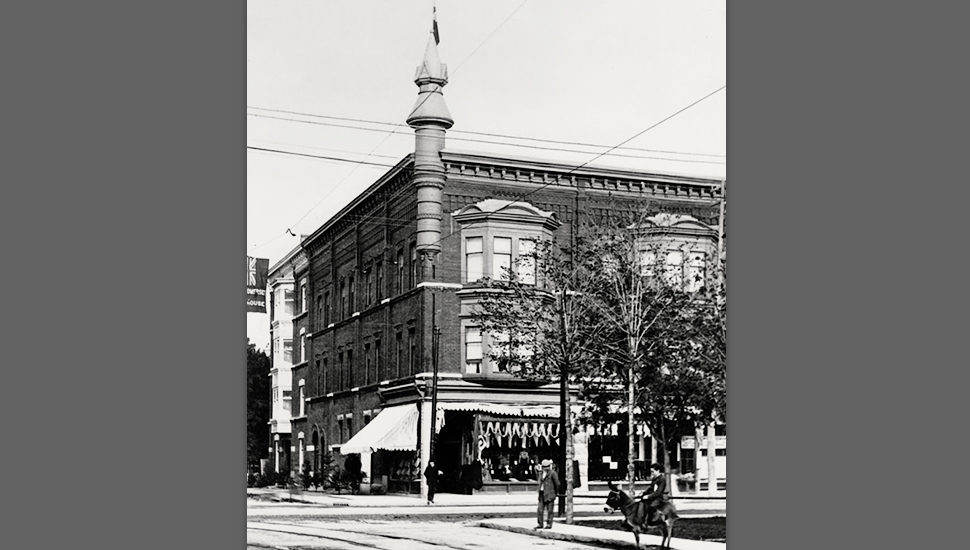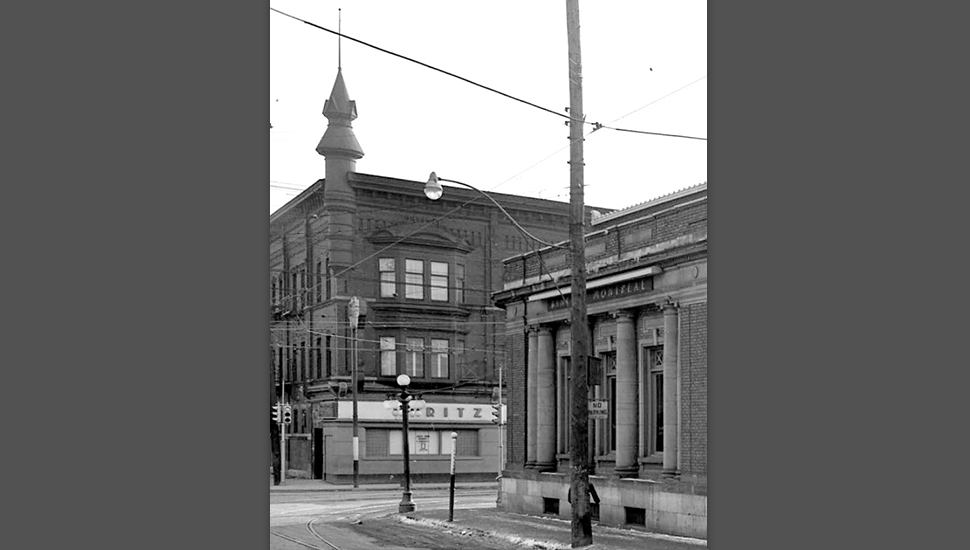48. Somerset House
Construction: 1897-1898
Builder: Thomas Clarey
Location: 352 Somerset Street West, Ottawa
Somerset House anchors the southeast corner of Bank Street and Somerset Street West. Its construction is attributed to contractor Thomas Clarey, who purchased the lot in 1897 to build the 3-storey commercial block.
Designed in a Victorian Italianate style, the building is of solid red brick construction with contrasting stone banding and brick corbelling on the upper two floors. The main elevation facing Bank Street had large display windows and double entry doors on the ground floor with a sheet metal entablature carried on cast-iron columns simulating cut stone (cast by Baldwin Iron Works of Ottawa (1891-1899). The upper floors were notable for their large bay windows, one flanked by semi-circular windows with brick arches and stamped sheet metal caps.
Somerset House’s most distinctive feature was the sheet metal turret protruding from the northwest corner. When constructed, it was topped by a decorative conical-shaped sheet metal roof.
In 1900 a 4-storey, flat-roofed apartment block in a similar style was added to the east end of the building. Over the years, various commercial tenants have occupied the site. There have been several name changes, including Crosby & Carruthers Dry Goods Co. (1898), The Emporium (1907), Fleetwood Wilson’s Store (1916), the Ritz Hotel (1937) and Somerset House (1973).
Somerset House was designated under Part V of the Ontario Heritage Act in 1997 as part of the Centretown Heritage Conservation District.
The pubs that occupied the building were already in slow decline, as Ottawa’s nightlife moved elsewhere. They closed on October 31, 2004.
In 2004, TKS Holdings purchased Somerset House and prepared renovations plans to modernize interior spaces.
In September, 2007 preparation work had started on a new basement floor slab. On October 19, a worker using a Bobcat knocked out a key support, causing a partial collapse of the southeast corner of the building. Ottawa’s Chief Building Official issued an emergency demolition order for the building.
The City’s Planning and Development Committee met in November to deal with the issue. Then president of Heritage Ottawa, David Flemming, urged the City to take all measures to protect the historic landmark. Flemming stressed the need for an emergency protocol to deal with buildings at risk and offered Heritage Ottawa’s services in drafting such a document.
To help raise public awareness, Heritage Ottawa launched a media blitz about the lack of municipal tools to prevent this kind of deterioration.
On December 9, 2007 Heritage Ottawa submitted a draft emergency protocol to the Mayor and councillors. The protocol would bring city departments (Heritage Planning, Property Standards, Building Code, etc.) together to quickly address heritage building deficiencies in order to prevent demolition-by-neglect.
At the same time, Sandy Smallwood, president of Historic Ottawa Development Inc. (HODI), met with the owner of Somerset House, Tony Shahrasebi, who agreed to hire an experienced heritage engineer to develop a stabilization plan. The plan would require the controlled demolition of a portion of the building—issued by the Building Code Services Branch—to permit safe access to stabilize the structure.
This stabilization plan was ultimately rejected by Shahrasebi. The City carried out the work under the authority of the Property Standards Bylaw, and billed TKS Holding. After a protracted legal battle, in December 2012 the two parties settled out of court.
In the fall of 2013, City Council approved a new application to revitalize the building. The owner, however, neglected to apply for the necessary permit, leaving Somerset House to deteriorate further.
In February, 2016, Council updated the Property Standards Bylaw to include the provision that prescribes minimum standards for the maintenance of heritage attributes of properties designed under Parts IV and V of the Ontario Heritage Act, which the Act empowers municipalities to implement.
City Council also approved the emergency protocol proposed by Heritage Ottawa. Its implementation is closely monitored by the City and is reported regularly to the Mayor’s Task Force on Heritage Matters established in 2016. One important spin-off from this initiative has been to gradually (over three years) reduce the tax credit to owners of vacant buildings from 30% to 0%, removing an incentive to neglect their properties.
In July 2016, the City reluctantly agreed to allow demolition of part of the Somerset Street façade, which was unstable and a danger to pedestrians.
Another proposal for rehabilitating Somerset House was approved by Council in May 2017.
Somerset House remains one of Ottawa’s poster-children for demolition-by-neglect.
Heritage Ottawa has spent years advocating against "demolition-by-neglect", a major issue in the preservation of heritage properties. In 2016 the City of Ottawa updated the Property Standards By-Law to include specific protection for heritage properties suffering neglect. Heritage Ottawa will continue to advocate for the enforcement of this By-Law.
Related Reading:
Heritage Ottawa Opposes Demolition by Neglect of Somerset House | June 30, 2016
Heritage Ottawa Supports Stronger Measures to Save Somerset House | September 18, 2018
Owner of Somerset House Would Rather Tear it Down, Build a Replica Building | Ottawa Citizen, November 16, 2018
More Delays for Somerset House Restoration | OttawaMatters, June 11, 2019





